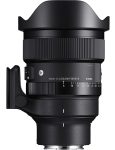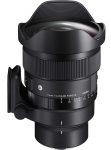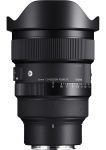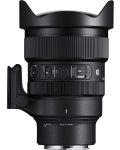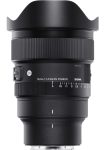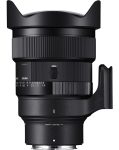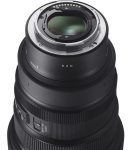Sigma 15mm F/1.4 DG DN Fisheye | A
Fisheye lens • Digital era
- Announced:
- · February 2024
- Production status:
- ● In production
- Country of design:
- · Japan
- Original name:
- · SIGMA 15mm 1:1.4 DG DN FISHEYE A
- Class:
- · Ultra-fast full-frame diagonal fisheye lens
- System:
- · Leica L (2015)
Abbreviations
| DG | The lens is designed for 35mm digital cameras but can be also used on APS-C digital cameras. |
| DN | The lens is optimized for cameras with a short flange back distance. |
| FISHEYE | An ultra-wide angle lens with strong uncorrected barrel distortion and extreme angle of view. |
| | A | Belongs to the Art series lenses. |
Specification
| Optical design: | |
| 35mm full frame | |
| 15mm | |
| F/1.4 | |
| 21 elements in 15 groups | |
| 2 ASPH, 3 SLD, 4 FLD | |
| Internal focusing (IF) | |
| Diagonal (full-frame) fisheye | |
| Leica L | |
| Sony E | |
| 180° | |
| Diaphragm mechanism: | |
Diaphragm type: | Automatic |
Aperture control: | Aperture ring (Manual settings + Auto Exposure setting) |
| 11 (eleven) | |
| Focusing: | |
| 0.385m | |
| 1:16 | |
Focusing modes: | Autofocus (AF), Manual focus (MF) |
Autofocus motor: | High-response Linear Actuator |
Manual focus control: | Focusing ring |
Focus mode selector: | AF - MF |
Manual focus override in autofocus mode: | Determined by the camera |
| Optical Stabilizer (OS): | |
| - | |
| Physical characteristics: | |
| 1360g (Leica L) | |
| 1360g (Sony E) | |
| ⌀104×157.9mm (Leica L) | |
| ⌀104×159.9mm (Sony E) | |
| Dust-proof and water-resistant barrel | |
| Yes | |
| Accessories: | |
| Removable front filters are not accepted | |
Additional features: | Rear gelatin filter holder |
| Built-in petal-shaped | |
| Not compatible |
Source of data
- Manufacturer's technical data.
Manufacturer description
The world's first* F1.4 diagonal fisheye interchangeable lens for 35mm full-frame. Unparalleled resolving power that overturns the conventional wisdom about fisheye lenses.
* As an interchangeable lens for full-frame cameras for consumer use. (As of February 2024 by SIGMA)
In developing a fisheye lens featuring an ultra-wide-angle and powerful fisheye distortion, SIGMA has achieved a completely new level of artistic potential, combining the world's first F1.4 aperture for consumer use with outstanding resolving power across the entire image. In terms of optical performance, the SIGMA 15mm F1.4 DG DN DIAGONAL FISHEYE | Art has achieved excellent point image reproducibility and high resolution by correcting various aberrations, especially sagittal coma flare. The lens is capable of handling starscape photography, which demands particularly high-quality performance, even when wide-open. Unlike conventional fisheyes, the SIGMA 15mm F1.4 DG DN DIAGONAL FISHEYE | Art is exceptionally sharp across its entire 180° angle-of-view and offers an ultra-fast F1.4 aperture, making it perfect for a wide range of applications including astrophotography, landscapes and architecture. The expressive power of this all-new full-frame mirrorless lens opens a wealth of creative possibilities in wide-angle photography.
The latest optical design thoroughly corrects each type of aberration. This diagonal fisheye lens has the unique expressiveness of a fisheye lens and high resolution throughout the entire image from a wide-open aperture. The performance of the lens is guaranteed by a full inspection with SIGMA's proprietary MTF measuring system.
The lens consists of 21 elements in 15 groups, including 4 FLD and 3 SLD exclusive low-dispersion glass elements, and 2 aspherical lens elements. By correcting sagittal coma flare and other aberrations, the lens can precisely reproduce bright points of light across the whole frame even wide open, making it ideal for astrophotography.
The powerful distortion effect, which is the appeal of fisheye lenses, allows users to enjoy expressions such as a unique perspective and emphasis on the subject at a 180° angle of view. In addition, the SIGMA 15mm F1.4 DG DN DIAGONAL FISHEYE | Art is designed with the strict performance standards of the Art line. Furthermore, all lenses are inspected with SIGMA's proprietary MTF measuring system. The unique descriptive power of this new fisheye lens, which combines an incredible 180° angle-of-view with very high resolution optics, delivers a level of artistic potential that exceeds other fisheye lenses.
To prevent flare and ghosting, which reduce image quality, the lens is designed to handle all conditions of incident light based on state-of-the-art simulation technology. High backlight resistance enables clear and sharp images under any lighting conditions.
The SIGMA 15mm F1.4 DG DN DIAGONAL FISHEYE | Art offers an abundant functions to support astrophotography. With the introduction of this lens, SIGMA now has four F1.4 wide-angle prime Art line lenses with functions specifically designed for astrophotography, including the 14mm, 20mm, and 24mm. In terms of both lineup and functionality, SIGMA fully supports the joy of capturing the stars.
The SIGMA Art line of F1.4 single focal length lenses with specialized features for astrophotography is expanded to four lenses with the addition of the SIGMA 15mm F1.4 DG DN DIAGONAL FISHEYE | Art. Users can select the lens that best suits their needs and the expression they are aiming for.
The lens is equipped with an MFL switch. When the MFL switch is set to “LOCK,” the focus ring operation is disabled, ensuring that once focus is acquired, it will not be changed by unintentional movement of the ring. This is useful for long exposures and other situations where the focus should be fixed while shooting.
A small step at the front of the lens called a lens heater retainer prevents the lens heater* from protruding over the front element, eliminating the risk of vignetting.
*A belt-shaped heat strip that is wrapped around the lens to prevent condensation from forming inside the lens when the temperature drops.
A standard-equipped rear filter holder at the lens mount allows sheet-type filters to be used.
The included cover lens cap features two slots to securely store rear filters, as well as a locking mechanism. The cap is specially designed for the SIGMA 15mm F1.4 DG DN DIAGONAL FISHEYE | Art, allowing users to carry sheet-type filters without the risk of confusing or forgetting them, while protecting them from scratches and dirt.
The lens is equipped with an Arca-Swiss compatible, lightweight and sturdy magnesium alloy tripod socket. The detachable leg can be mounted on a tripod for stable conditions even during long exposures. The shape has been deliberately designed to prevent interference when using a lens heater.
*The tripod socket TS-141 is also compatible with the SIGMA 14mm F1.4 DG DN | Art.
The SIGMA 15mm F1.4 DG DN DIAGONAL FISHEYE | Art is equipped with various functions to assist shooting, including an AFL button to which preferred function can be assigned and an aperture ring, and uses a linear motor HLA (High-response Linear Actuator) as the AF actuator to enable fast, quiet, and highly accurate AF shooting. The lens is also equipped with a dust and splash resistant structure to ensure a high level of weather resistance and robustness, as well as excellent build quality that allows for long and reliable use in any environment.
The lens is equipped with an AFL button which can be assigned to a range of functions via the menu on selected cameras. In addition to the aperture ring, the lens is equipped with an aperture ring lock switch and a click switch to turn the click on and off.
In addition to a dust and splash resistant structure, the front element of the lens features a water and oil repellent coating, allowing photographers to shoot without concerns even in harsh outdoor environments.
The AF actuator is a linear motor HLA (High-response Linear Actuator). The high thrust motor operates the focus lens at high speed and with high precision to provide comfortable AF shooting.
To support the heavy optical system and enhance robustness and reliability, metal parts are used in key parts of the lens body. Meanwhile, the lightweight engineering plastic TSC* is also used in appropriate places to reduce weight. Furthermore, each control part, such as rings and switches, is designed to feel good. SIGMA is proud of the exceptional build quality of its products, which do not compromise on durability, operability, and a satisfying sense of ownership.
* TSC (Thermally Stable Composite) is a type of polycarbonate with a thermal expansion rate similar to that of aluminum. It has a high affinity to metal parts which contributes to high quality product manufacturing.
Typical characteristics of fisheye lenses
- Extreme angle of view (at least 180° diagonally);
- Circular types (the image circle of the lens is inscribed in the image frame) or diagonal types (cover the entire image frame);
- Usually of equidistant projection type, with the distance from the picture center to any given point always proportional to the angle from the optical axis to that point;
- Huge barrel distortion;
- Short closest focusing distance (0.20 - 0.30m with 35mm full-frame prime lenses);
- Very large depth of field, eliminating the need for autofocus or precise manual focusing;
- Due to the extreme angle of view and convex front element, front filters cannot be used;
- Often equipped with a filter turret with swivel-mounted filters;
- Often come with a small, built-in petal-shaped lens hood.
From the editor
A monster among fisheye lenses. A model equipped with all imaginable and inconceivable professional functions. This lens, in fact, is the flagship model among all SIGMA lenses, and fully demonstrates the company’s capabilities in developing photographic lenses:
- It has a sophisticated optical design comparable to modern professional zoom lenses;
- The record speed of F/1.4 for a fisheye lens allows it to be used for interior photography;
- For fisheye lenses, automatic focusing is not necessary due to the large depth of field at any focusing distance, however, SIGMA equipped this lens with a High-response Linear Actuator.
Since the lens was developed from the very beginning as a professional model, SIGMA did not have such strict restrictions in terms of weight and dimensions that are usually set for amateur optics. As a result, the 15mm F/1.4 is very heavy and quite large for a fisheye lens, and must be used on a tripod.

